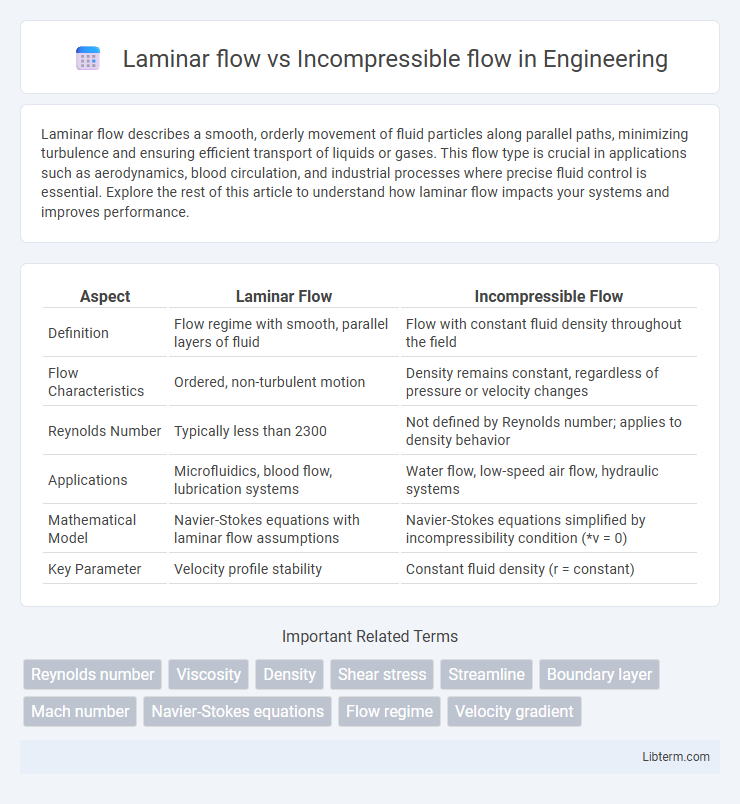Laminar flow describes a smooth, orderly movement of fluid particles along parallel paths, minimizing turbulence and ensuring efficient transport of liquids or gases. This flow type is crucial in applications such as aerodynamics, blood circulation, and industrial processes where precise fluid control is essential. Explore the rest of this article to understand how laminar flow impacts your systems and improves performance.
Table of Comparison
| Aspect | Laminar Flow | Incompressible Flow |
|---|---|---|
| Definition | Flow regime with smooth, parallel layers of fluid | Flow with constant fluid density throughout the field |
| Flow Characteristics | Ordered, non-turbulent motion | Density remains constant, regardless of pressure or velocity changes |
| Reynolds Number | Typically less than 2300 | Not defined by Reynolds number; applies to density behavior |
| Applications | Microfluidics, blood flow, lubrication systems | Water flow, low-speed air flow, hydraulic systems |
| Mathematical Model | Navier-Stokes equations with laminar flow assumptions | Navier-Stokes equations simplified by incompressibility condition (*v = 0) |
| Key Parameter | Velocity profile stability | Constant fluid density (r = constant) |
Introduction to Laminar Flow and Incompressible Flow
Laminar flow refers to a fluid motion characterized by smooth, orderly layers with minimal mixing between them, typically occurring at low Reynolds numbers below 2,000. Incompressible flow assumes constant fluid density throughout the flow field, often valid for liquids and low-speed gas flows where density variations are negligible. Understanding the distinction helps in analyzing fluid behavior for applications in aerodynamics, hydraulics, and process engineering.
Defining Laminar Flow: Characteristics and Behavior
Laminar flow is characterized by smooth, orderly fluid motion in parallel layers with minimal mixing and low Reynolds numbers, typically below 2000. It exhibits predictable velocity profiles and stable flow patterns, where fluid particles move along fixed paths without turbulence. This flow behavior commonly occurs in fluids with low viscosity and slow velocities, ensuring minimal energy loss and uniform shear stress distribution.
Understanding Incompressible Flow: Key Concepts
Incompressible flow refers to fluid motion where the fluid density remains constant despite pressure variations, a key assumption in many fluid dynamics problems. This concept simplifies the Navier-Stokes equations, enabling easier analysis of laminar flow, which is characterized by smooth, orderly fluid layers moving in parallel without significant mixing. Understanding incompressible flow is essential for accurately predicting velocity fields, pressure distribution, and shear stress in engineering applications such as pipe flow, airfoil aerodynamics, and cardiac blood flow modeling.
Fundamental Differences: Laminar vs Incompressible Flow
Laminar flow describes a fluid motion where layers move smoothly in parallel without disruption, characterized by low Reynolds numbers typically below 2300. Incompressible flow assumes constant fluid density throughout, often applied to liquids or gases at low Mach numbers, simplifying continuity equations. The fundamental difference lies in laminar flow specifying flow regime and velocity profile smoothness, whereas incompressible flow defines density behavior regardless of flow regime.
Fluid Mechanics Principles Underlying Each Flow Type
Laminar flow describes a fluid motion with smooth, parallel layers where viscous forces dominate, resulting in a low Reynolds number and minimal mixing between layers. Incompressible flow assumes constant fluid density, simplifying the continuity equation and allowing the divergence of velocity to be zero, which is valid for many liquids and low-speed gas flows. Both concepts rely on Navier-Stokes equations, but laminar flow emphasizes viscous effects while incompressible flow highlights density invariance in fluid mechanics.
Mathematical Models: Comparing Laminar and Incompressible Equations
Laminar flow is characterized by smooth, orderly fluid motion modeled by the Navier-Stokes equations under low Reynolds number conditions, where velocity gradients remain stable and predictable. Incompressible flow assumes constant fluid density, simplifying the continuity equation to divergence-free velocity fields, which applies to both laminar and turbulent regimes. Comparing mathematical models, laminar flow equations emphasize viscous forces with linear velocity profiles, whereas incompressible flow models prioritize mass conservation constraints without density variations, making incompressible laminar flow a subset governed by both these conditions.
Real-World Examples of Laminar Flow Applications
Laminar flow, characterized by smooth, orderly fluid motion with parallel layers, contrasts with incompressible flow, a condition where fluid density remains constant despite pressure changes. Real-world applications of laminar flow include aerodynamic designs in aircraft wings for reduced drag, precise inkjet printing for high-resolution images, and medical devices such as blood flow meters ensuring accurate measurements. These examples highlight the importance of laminar flow in optimizing efficiency and performance across engineering and biomedical fields.
Practical Uses of Incompressible Flow in Engineering
Incompressible flow, characterized by constant density, is crucial in engineering applications such as hydraulic system design, aerodynamics of low-speed aircraft, and water supply network analysis. Its practical use simplifies the mathematical modeling of fluid behavior in pipelines and open channels, enabling efficient calculation of pressure drops and flow rates. Engineers rely on incompressible flow assumptions to optimize pump and turbine performance, improving energy efficiency in fluid machinery.
Advantages and Limitations of Each Flow Type
Laminar flow offers advantages such as predictable velocity profiles and low friction losses, making it ideal for applications requiring smooth, stable fluid movement, yet it is limited by low Reynolds numbers and less effective mixing capabilities. Incompressible flow simplifies analysis by assuming constant density, which benefits hydraulic and aerodynamics problems, but it cannot accurately model compressibility effects in high-speed or high-pressure scenarios. Both flow types serve specific engineering purposes, with laminar flow excelling in precision and incompressible flow providing practical approximations for many real-world fluid systems.
Conclusion: Choosing Between Laminar and Incompressible Flow
Choosing between laminar flow and incompressible flow depends on the specific fluid dynamics and application requirements. Laminar flow, characterized by smooth, orderly fluid motion, is ideal for minimizing turbulence and ensuring precise control in low Reynolds number conditions. Incompressible flow assumes constant fluid density, simplifying analysis for liquids and slow-moving gases, making it suitable for many engineering problems where density changes are negligible.
Laminar flow Infographic

 libterm.com
libterm.com